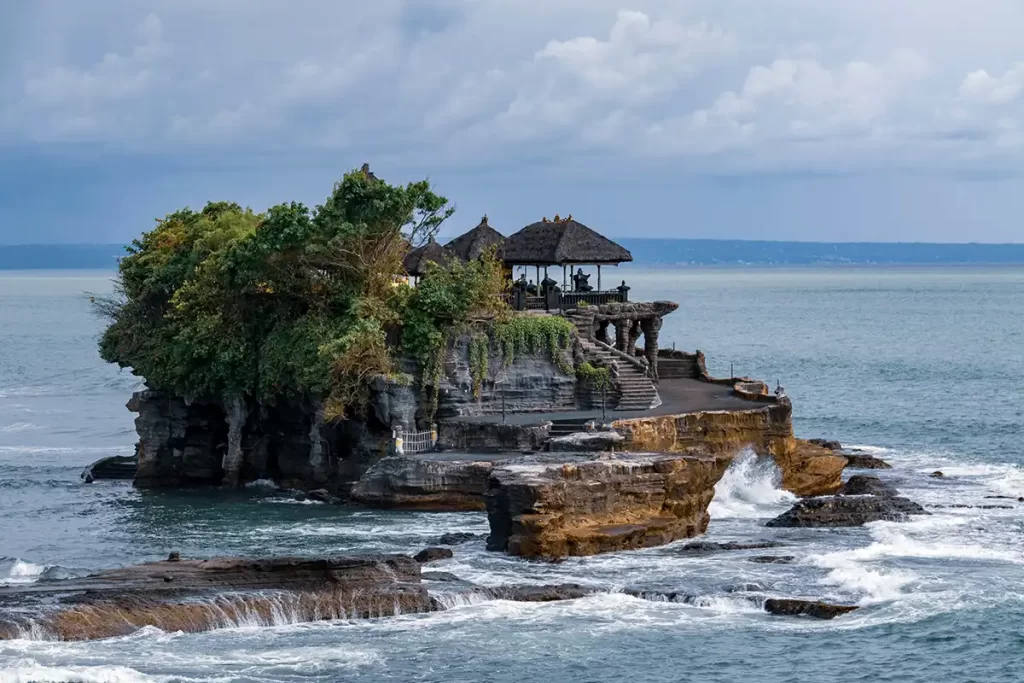Pura Tanah Lot stands as one of the island’s most iconic landmarks. With its silhouette etched against the horizon, this ancient sea temple captures the imagination of all who visit. Beyond its stunning beauty, Pura Tanah Lot holds deep spiritual significance for the Balinese people and offers a window into the rich cultural heritage of Bali. This article provides a comprehensive guide to Pura Tanah Lot, delving into its history, cultural importance, architectural marvels, and practical tips for visitors.
History of Pura Tanah Lot
The origins of Pura Tanah Lot are steeped in legend, closely linked to the 16th-century Hindu priest Dang Hyang Nirartha. According to Balinese folklore, Nirartha embarked on a spiritual journey across Bali to spread the teachings of Hinduism. During his travels, he reached the coast where Pura Tanah Lot now stands. Enchanted by the beauty and serenity of the location, he decided to rest there for the night. It is said that Nirartha received a divine vision instructing him to build a temple on the rock, which would be dedicated to the sea gods. Thus, Pura Tanah Lot was born, becoming a sacred site where the Balinese people could honor the deities of the ocean.
Historically, Pura Tanah Lot played a significant role in the spread of Hinduism in Bali. The temple became a focal point for religious ceremonies and rituals, strengthening the spiritual bond between the Balinese people and their gods. Over the centuries, the temple has undergone several renovations and restorations, particularly in response to the erosion of the rock foundation by the relentless waves. Despite these changes, Pura Tanah Lot has retained its original charm and continues to be a vital part of Bali’s religious and cultural landscape.
Cultural Significance of Pura Tanah Lot
Pura Tanah Lot holds immense religious importance in Balinese Hinduism. As a sea temple, it is one of the seven temples that form a chain along Bali’s coast, each dedicated to the protection of the island from the forces of the ocean. The temple is a site of pilgrimage for Balinese Hindus, who come to pay homage to the sea gods and seek blessings for prosperity and protection. During significant religious festivals, Pura Tanah Lot becomes the center of vibrant ceremonies, with offerings, prayers, and traditional performances filling the temple grounds.
The rituals and traditions associated with Pura Tanah Lot are deeply ingrained in Balinese culture. One of the most notable ceremonies is the Melasti ritual, held before the Balinese New Year (Nyepi). During Melasti, devotees carry sacred objects from their village temples to Pura Tanah Lot to be purified by the sea. This ritual symbolizes the cleansing of the body and soul, and the renewal of spiritual energy
Read more: Embracing the Silence Day: What to Do During Nyepi Day in Bali
Symbolically, the temple’s architecture and location reflect the Balinese belief in the harmony between humans, nature, and the spiritual world. The towering pagoda-like shrine, or meru, represents the sacred Mount Meru, the axis of the universe in Hindu cosmology. The temple’s position on the edge of the sea symbolizes the boundary between the earthly realm and the divine, a place where humans can connect with the gods.
Architecture and Design of Pura Tanah Lot
The architecture of Pura Tanah Lot is a testament to the ingenuity of Balinese craftsmanship. The temple complex consists of several shrines and pavilions, each with its own unique purpose. The main shrine, perched atop the rock formation, is the most revered part of the temple. This shrine is accessible only during low tide, when a narrow strip of land connects the rock to the mainland. The surrounding buildings, including smaller shrines and gathering areas, are built in the traditional Balinese style, characterized by intricate stone carvings, wooden structures, and thatched roofs.
Balinese architectural motifs are evident throughout the temple complex. The use of stone and wood, along with the incorporation of floral and faunal patterns, reflects the Balinese reverence for nature. The temple gates, known as candi bentar, are intricately carved with scenes from Hindu epics and are a distinctive feature of Balinese temple architecture.
One of the most striking aspects of Pura Tanah Lot is its unique location. The temple is built on a rock formation that juts out into the sea, making it appear as if it is floating during high tide. This dramatic setting adds to the temple’s mystical aura and has made it one of the most photographed sites in Bali.
Pura Tanah Lot as a Tourist Destination
Pura Tanah Lot is undoubtedly one of Bali’s most popular tourist attractions. Its breathtaking beauty, combined with its cultural and spiritual significance, draws visitors from around the world. The temple is particularly famous for its stunning sunsets, when the silhouette of the temple against the vibrant sky creates a magical scene.
The best time to visit Pura Tanah Lot is during the dry season, from April to September, when the weather is pleasant and the skies are clear. Early morning or late afternoon are ideal times to visit, as these periods offer cooler temperatures and fewer crowds. However, sunset remains the most popular time to experience the temple, so it’s advisable to arrive early to secure a good viewing spot.
Visitors to Pura Tanah Lot can engage in a variety of activities, from exploring the temple complex and learning about its history to capturing photographs of the breathtaking scenery. The temple grounds also feature shops selling souvenirs, local crafts, and refreshments. Nearby, visitors can explore other attractions, such as the Batu Bolong Temple, a smaller sea temple located on a rocky promontory, and the beautiful beaches that stretch along Bali’s coast.
Read moe: Tips for First-Timers in Bali: A Guide to an Unforgettable Adventure
Additional Informations About Pura Tanah Lot
How to Get To Pura Tanah Lot
Getting to Pura Tanah Lot is relatively straightforward. The temple is located about 20 kilometers from Denpasar, Bali’s capital, and can be reached by car or motorbike. Many tour operators offer guided tours to Pura Tanah Lot, often combined with visits to other nearby attractions.
Entrance Fee and Dress Code
There is an entrance fee to visit Pura Tanah Lot, which helps fund the temple’s maintenance and preservation. Additional charges may apply for activities such as photography or parking. Visitors should also be mindful of the dress code, as Pura Tanah Lot is a sacred site. Modest clothing is required, with sarongs and sashes available for rent at the entrance if needed.
Local Customs And Traditions
To make the most of a visit to Pura Tanah Lot, it’s important to respect local customs and traditions. Avoid touching or stepping on offerings, and be mindful of the temple’s sacred areas, which may be off-limits to non-Hindus. Additionally, visiting during off-peak hours can enhance the experience, allowing for a more peaceful and reflective visit.
Pura Tanah Lot is more than just a stunning tourist attraction; it is a symbol of Bali’s rich cultural and spiritual heritage. From its legendary origins and religious significance to its breathtaking architecture and scenic beauty, Pura Tanah Lot offers a glimpse into the heart of Balinese culture. Whether you are drawn by its history, its beauty, or its spiritual ambiance, a visit to Pura Tanah Lot is an unforgettable experience. So, take the time to explore this sacred site, and let the magic of Pura Tanah Lot leave a lasting impression on your journey through Bali.
Frequently Asked Questions About Pura Tanah Lot
1. Can you enter Pura Tanah Lot during high tide?
No, you cannot enter the main temple of Pura Tanah Lot during high tide. The temple is located on a rock formation surrounded by the sea, and during high tide, the pathway leading to the temple is submerged. However, you can still enjoy the view of the temple from the shore and take photos. Visiting during low tide allows you to walk across the exposed path and get closer to the temple.
2. Are there any accommodations near Pura Tanah Lot?
Yes, there are several accommodations near Pura Tanah Lot, ranging from luxury resorts to budget-friendly hotels and homestays. Many of these places offer stunning views of the temple and the ocean, making them popular choices for visitors who want to stay close to this iconic site. Some well-known options include the Pan Pacific Nirwana Bali Resort (now rebranded) and smaller boutique hotels in the nearby village of Beraban.
3. What is the significance of the snakes at Pura Tanah Lot?
The snakes at Pura Tanah Lot are considered sacred and are believed to be protectors of the temple. According to local legend, these sea snakes were created by the Hindu priest Dang Hyang Nirartha to guard the temple from evil spirits and intruders. Visitors can see these snakes in a small cave near the base of the temple, and local guides often explain their significance to curious tourists.
4. Is there a local market or shopping area near Pura Tanah Lot?
Yes, there is a local market near the entrance of Pura Tanah Lot where visitors can shop for souvenirs, handicrafts, clothing, and local snacks. The market is a great place to buy traditional Balinese items such as sarongs, wooden carvings, and silver jewelry. Bargaining is common, so feel free to negotiate prices with the vendors.
5. What are some lesser-known tips for photographing Pura Tanah Lot?
For the best photographs of Pura Tanah Lot, consider the following tips:
- Golden Hour: Arrive early in the morning or stay until the golden hour before sunset for the most flattering natural light.
- Tide Timing: Plan your visit around low tide if you want to get closer to the temple, but high tide offers dramatic shots of the temple surrounded by water.
- Vantage Points: Explore different angles by walking along the cliffs or heading to the nearby Batu Bolong Temple for a unique perspective.
- Weather Conditions: Check the weather forecast before visiting; clear skies provide the best conditions for photography, but overcast skies can create moody and atmospheric shots.











